12882
N16E79 Data 2021-10-03
Long Jupiter -40 area 180
 New region 12882 [N16E79] 180 rotated into view near noon.
New region 12882 [N16E79] 180 rotated into view near noon.report(past month only)
12882
N16E66 Data 2021-10-04
Long Jupiter -26 area 250
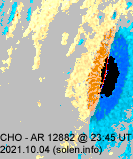 Region 12882 [N16E66] 250 was quiet and stable.
Region 12882 [N16E66] 250 was quiet and stable.report(past month only)
12882
N16E53 Data 2021-10-05
Long Jupiter -12 area 200
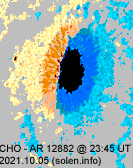 Region 12882 [N16E53] 200 was quiet and stable.
Region 12882 [N16E53] 200 was quiet and stable.report(past month only)
12882
N16E40 Data 2021-10-06
Long Jupiter 2 area 240
 Region 12882 [N16E40] 240 gained tiny trailing spots and was mostly quiet. The region produced a C5.5 flare at 02:46 UT on October 7.
Region 12882 [N16E40] 240 gained tiny trailing spots and was mostly quiet. The region produced a C5.5 flare at 02:46 UT on October 7.report(past month only)
12882
N17E27 Data 2021-10-07
Long Jupiter 15 area 230
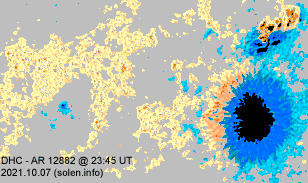 Region 12882 [N17E27] 230 developed a magnetic delta structure as new flux emerged to the north of the main penumbra. M class flares are possible.
Region 12882 [N17E27] 230 developed a magnetic delta structure as new flux emerged to the north of the main penumbra. M class flares are possible.report(past month only)
12882
N18E14 Data 2021-10-08
Long Jupiter 29 area 240
 Region 12882 [N18E14] 240 gained spots in the northern spot section and produced 2 C flares (C1.9 at 11:08 and a long duration C2.7 event peaking at 19:56 UT).
Region 12882 [N18E14] 240 gained spots in the northern spot section and produced 2 C flares (C1.9 at 11:08 and a long duration C2.7 event peaking at 19:56 UT).report(past month only)
12882
N18E00 Data 2021-10-09
Long Jupiter 44 area 280
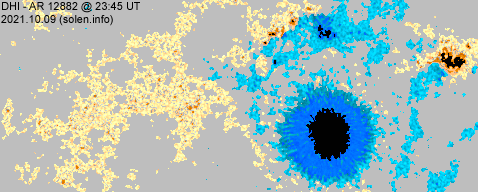 Region 12882 [N18E00] 280 produced a minor M1.6 long duration event peaking at 06:38 UT. After the flare some small spots disappeared.
Region 12882 [N18E00] 280 produced a minor M1.6 long duration event peaking at 06:38 UT. After the flare some small spots disappeared.report(past month only)
12882
N18E00 Data 2021-10-10
Long Jupiter 45 area 260
 Region 12882 [N18E00] 260 was quiet and in slow decay.
Region 12882 [N18E00] 260 was quiet and in slow decay.report(past month only)
12882
N17W13 Data 2021-10-11
Long Jupiter 58 area 250
 Region 12882 [N17W13] 250 was quiet and in slow decay.
Region 12882 [N17W13] 250 was quiet and in slow decay.report(past month only)
12882
N17W39 Data 2021-10-12
Long Jupiter 86 area 270
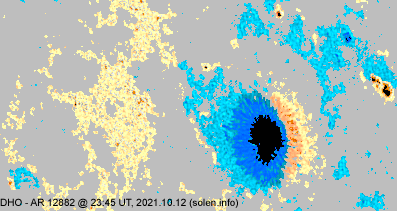 Region 12882 [N17W39] 270 was mostly quiet. A B9 flare at 01:40 UT triggered activity in a filament to the west and north of the region. The filament eruption was associated with a partial halo CME.
Region 12882 [N17W39] 270 was mostly quiet. A B9 flare at 01:40 UT triggered activity in a filament to the west and north of the region. The filament eruption was associated with a partial halo CME.report(past month only)
12882
N15W52 Data 2021-10-13
Long Jupiter 100 area 260
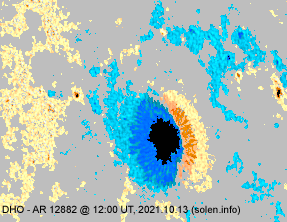 Region 12882 [N15W52] 260 decayed slowly and quietly.
Region 12882 [N15W52] 260 decayed slowly and quietly.report(past month only)
12882
N15W65 Data 2021-10-14
Long Jupiter 114 area 250
 Region 12882 [N15W65] 250 decayed slowly and quietly.
Region 12882 [N15W65] 250 decayed slowly and quietly.report(past month only)
12882
N15W78 Data 2021-10-15
Long Jupiter 128 area 250
 Region 12882 [N15W78] 250 decayed slowly and quietly.
Region 12882 [N15W78] 250 decayed slowly and quietly.report(past month only)